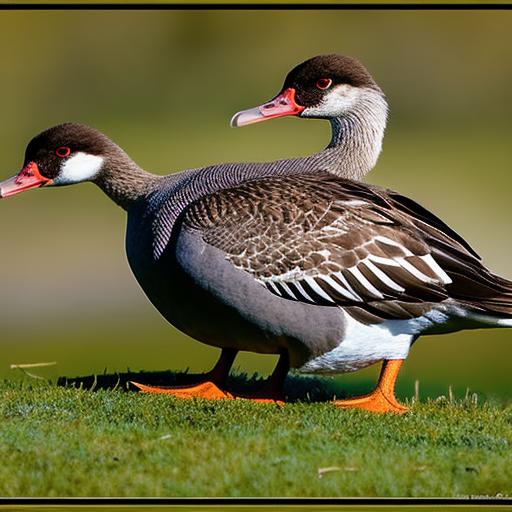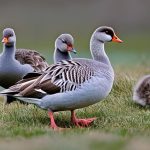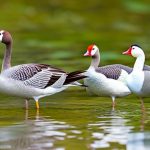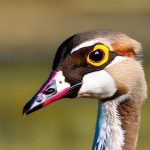Flightless geese are a fascinating example of evolution in action. These birds are believed to have evolved from their flying ancestors as a result of their habitat and lifestyle. Over time, flightless geese have adapted to living in environments where flight is not necessary for survival. This has led to the development of smaller wings and larger bodies, making flight impossible. The evolution of flightless geese is a prime example of how animals can adapt to their surroundings in order to thrive.
The evolution of flightless geese can be traced back to their ancestors, who were likely able to fly. As these birds migrated to new environments, they encountered challenges that made flight less advantageous. In some cases, flightless geese may have found that they could find enough food and avoid predators without the need for flight. Over time, these birds evolved to become flightless, with adaptations such as reduced wing size and increased body mass. This allowed them to thrive in their new environments, and ultimately led to the development of distinct flightless goose breeds.
Characteristics of Flightless Geese Breeds
Flightless geese breeds are known for their distinctive physical characteristics that set them apart from their flying counterparts. These birds are typically larger and heavier than flying geese, with shorter wings that are unable to support flight. Flightless geese also have strong legs and feet, which they use for walking and swimming. Their bodies are well adapted to their terrestrial lifestyle, with strong muscles and a robust build.
In addition to their physical characteristics, flightless geese breeds also have unique behavioral traits. These birds are known for their strong social bonds and complex communication skills. They often form tight-knit family groups and are highly protective of their young. Flightless geese are also known for their intelligence and problem-solving abilities, which they use to navigate their environment and find food. Overall, flightless geese breeds are well adapted to their habitat and have developed a range of characteristics that allow them to thrive without the ability to fly.
Behavior and Habitat of Flightless Geese
Flightless geese are typically found in habitats that provide ample food and protection from predators. These birds are well adapted to living in wetland areas, where they can find a variety of plant matter and small aquatic creatures to eat. Flightless geese are also known for their ability to navigate both land and water, using their strong legs and webbed feet to move around their environment. They are often found in areas with tall grasses and reeds, which provide cover from predators and nesting sites for breeding pairs.
In terms of behavior, flightless geese are highly social animals that form strong family bonds. They are often seen in small groups or pairs, with each member playing a role in protecting the group and finding food. Flightless geese are also known for their vocalizations, which they use to communicate with each other and establish territory. Overall, flightless geese are well adapted to their habitat and have developed a range of behaviors that allow them to thrive in their environment.
Challenges Faced by Flightless Geese
Flightless geese face a number of challenges in their natural habitat, including predation, habitat loss, and competition for resources. These birds are vulnerable to predators such as foxes, raccoons, and birds of prey, which can pose a threat to both adults and young birds. In addition, flightless geese are at risk from habitat loss due to human development and climate change, which can reduce the availability of suitable nesting sites and food sources.
Competition for resources is another challenge faced by flightless geese, particularly in areas where they coexist with other bird species. In some cases, flightless geese may struggle to find enough food or suitable nesting sites due to competition from other birds. This can lead to decreased reproductive success and overall population decline. Overall, flightless geese face a range of challenges that can impact their survival and long-term viability as a species.
Conservation Efforts for Flightless Geese
Conservation efforts for flightless geese focus on protecting their natural habitat, reducing predation, and managing competition for resources. One key strategy is the creation of protected areas where flightless geese can thrive without the threat of habitat loss or human disturbance. These areas provide essential nesting sites and food sources for flightless geese, helping to support their populations.
In addition, efforts to reduce predation on flightless geese can help to improve their chances of survival. This may involve measures such as predator control or the creation of predator-proof nesting sites. Managing competition for resources is also important for the conservation of flightless geese, as it can help to ensure that these birds have access to enough food and suitable nesting sites.
Overall, conservation efforts for flightless geese play a crucial role in protecting these birds and ensuring their long-term survival. By addressing the key challenges they face in their natural habitat, conservationists can help to support healthy populations of flightless geese for future generations.
Interactions with Humans
Flightless geese have a complex relationship with humans, who have historically impacted their populations through hunting and habitat destruction. In some cases, flightless geese have been hunted for their meat and feathers, leading to population declines in certain areas. Habitat destruction due to human development has also had a negative impact on flightless geese populations, reducing the availability of suitable nesting sites and food sources.
However, humans also play a key role in the conservation of flightless geese through efforts such as protected areas and predator control. By creating protected areas where flightless geese can thrive without the threat of human disturbance, conservationists can help to support healthy populations of these birds. In addition, efforts to reduce predation on flightless geese can help to improve their chances of survival in areas where they coexist with humans.
Overall, the interactions between flightless geese and humans are complex and have both positive and negative impacts on these birds. By understanding these interactions and working towards conservation efforts, humans can play a crucial role in supporting healthy populations of flightless geese for future generations.
Future of Flightless Geese Breeds
The future of flightless geese breeds depends on the success of conservation efforts and the ability of these birds to adapt to changing environmental conditions. Conservation efforts play a crucial role in protecting flightless geese populations from threats such as predation, habitat loss, and competition for resources. By addressing these key challenges, conservationists can help to support healthy populations of flightless geese for future generations.
In addition, the ability of flightless geese to adapt to changing environmental conditions will be important for their long-term viability as a species. As climate change continues to impact habitats around the world, flightless geese will need to be able to find new food sources and nesting sites in order to survive. By understanding the behavior and habitat needs of flightless geese, conservationists can help these birds adapt to changing conditions and thrive in the future.
Overall, the future of flightless geese breeds depends on the success of conservation efforts and the ability of these birds to adapt to changing environmental conditions. By working towards these goals, humans can play a crucial role in supporting healthy populations of flightless geese for future generations.
Meet Walter, the feathered-friend fanatic of Florida! Nestled in the sunshine state, Walter struts through life with his feathered companions, clucking his way to happiness. With a coop that’s fancier than a five-star hotel, he’s the Don Juan of the chicken world. When he’s not teaching his hens to do the cha-cha, you’ll find him in a heated debate with his prized rooster, Sir Clucks-a-Lot. Walter’s poultry passion is no yolk; he’s the sunny-side-up guy you never knew you needed in your flock of friends!







